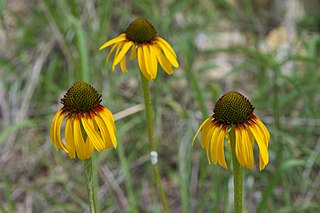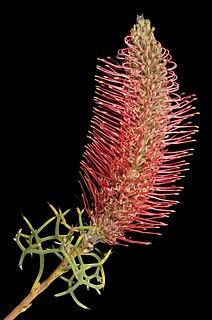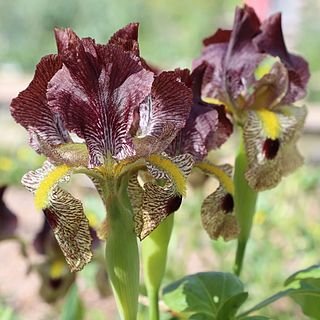
Hymenopodidae is a family of the order Mantodea (mantises), which contains six subfamilies. Some of the species in this family mimic flowers and are found camouflaged among them; these are called flower mantises. Their coloration is aggressive mimicry, luring prey to approach close enough to be seized and eaten.

Echinacea paradoxa, the yellow coneflower or Bush's purple coneflower, is a North American species of flowering plant in the sunflower family. It is native to southern Missouri, Arkansas, and south-central Oklahoma, with one isolated population reported from Montgomery County in eastern Texas. It is listed as threatened in Arkansas.

Fallugia is a monotypic genus of flowering plants containing the single species Fallugia paradoxa, which is known by the common names Apache plume and póñil. This plant is native to the southwestern United States and northern Mexico, where it is found in arid habitats such as desert woodlands and scrub.

Paradoxa Paradoxa (パラドクサ・パラドクサ), also known as Live at Kid Airak Hall. It is a live album of the Japanese noise group Merzbow's first live performance.
Veigaia is a genus of mites in the family Veigaiidae.
Veigaia carpillaris is a species of mite in the family Veigaiidae.
Veigaia cerva is a species of mite in the family Veigaiidae. It is found in Europe.
Veigaia formosana is a species of mite in the family Veigaiidae.
Veigaia hohuanshanensis is a species of mite in the family Veigaiidae.
Veigaia kochi is a species of mite in the family Veigaiidae. It is found in Europe.
Veigaia limulus is a species of mite in the family Veigaiidae.
Veigaia nemorensis is a species of mite in the family Veigaiidae. It is found in Europe.
Veigaia planicola is a species of mite in the family Veigaiidae. It is found in Europe.
Veigaia pseudouncata is a species of mite in the family Veigaiidae.
Veigaia uncata is a species of mite in the family Veigaiidae.

Tridal Production is an album by the Japanese noise musician Merzbow. It features studio material and a live excerpt from Paradoxa Paradoxa. It was partially included in the Merzbox. The full release was included in Lowest Music & Arts 1980–1983.

The Paradoxa Stoicorum is a work by the Academic Skeptic philosopher Cicero in which he attempts to explain six famous Stoic sayings that appear to go against common understanding.

Grevillea paradoxa, commonly known as the bottlebrush grevillea, is a shrub of the genus Grevillea native to an area in the Mid West, Wheatbelt and Goldfields-Esperance regions of Western Australia.

Iris paradoxa is a species of flowering plant native to western Asia. It has large upright petals and smaller lower petals, which is unique amongst most iris forms. They come in various shades from white, lavender, mauve, medium purple, violet, dark purple to black. It has a black or purplish black beard on the lower petals. It comes from the region of Transcaucasia, and is found in the countries of Iran,, Turkey, Armenia and in Azerbaijan.

Bartheletia paradoxa is a species of dimorphic fungus and is the only member of the genus Bartheletia. Bartheletia is the only genus in the family Bartheletiaceae, which is the only family in Bartheletiales, which in turn is the only order in the class Bartheletiomycetes. It infects the freshly fallen leaves of Ginkgo Biloba in the Autumn and persists through winter. Infection of a G. biloba leaf appears as tiny, sporadic black dots.








